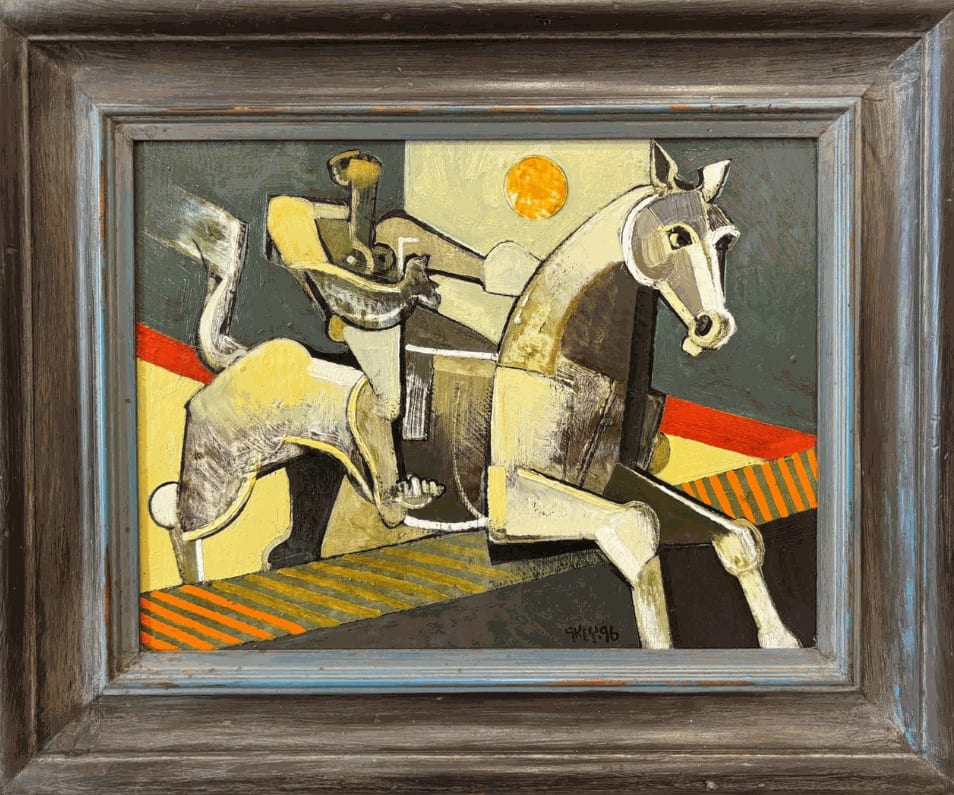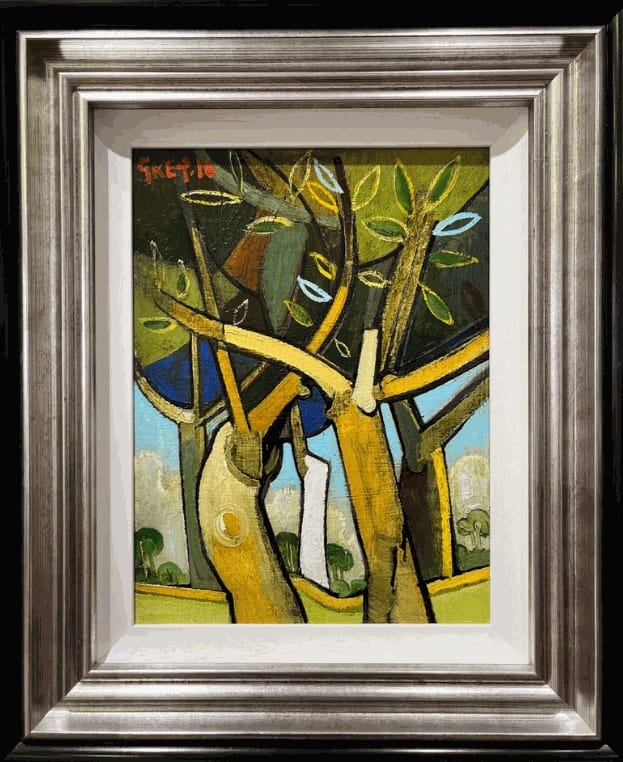In the quiet insistence of his line and the boldness of his form, Geoffrey Key brings something unmistakably Northern to British modern art. For over six decades, his work has shaped and reflected the cultural texture of the Salford art scene, straddling tradition and experimentation in a way that few modern British painters manage.
Whether through sculpture, drawing or oils, Geoffrey Key’s voice is at once rooted and unrestrained. You can explore Geoffrey Key art online, yet it’s often the in-person encounter that lingers longest.
Early Life and Education
Born in Manchester in 1941, Geoffrey Key’s creative instincts were shaped early by his surroundings and schooling. His mother, a trained artist herself, offered both encouragement and critique, two forces that arguably never left his process. He went on to study at the Manchester Regional College of Art, where tutors such as Harry Rutherford gave him a grounding in traditional draughtsmanship, even as his instincts leaned elsewhere.
This period was less about conformity and more a kind of negotiation between learning the rules and quietly twisting them. His first exhibitions followed not long after graduation, revealing an artist who, even then, seemed to be working from a private but confident logic. That push and pull between discipline and defiance has stayed with him throughout what’s become an expansive Geoffrey Key biography, still being written, one painting at a time.
Development of Style

There’s something about Geoffrey Key’s evolution that feels like watching a thought sharpen over time. His earliest works often leaned towards realism, grounded in observation and meticulous line. Yet as his confidence grew, so did the sense of abstraction. Figures began to stretch, forms took on rhythm, and the palette turned richer, more instinctive.
By the 1970s, a distinct visual language had emerged. You’ll see it in the curved silhouettes, the frequent play with shadow, and the way his subjects - human, animal, or architectural - seem to resist stillness. This wasn’t changed for the sake of novelty. Rather, it marked a shift in how he processed the world: less about recording, more about translating.
Through this lens, Key’s paintings move beyond the canvas and they start to speak. That sense of voice is perhaps why he sits comfortably among modern British painters, and why his style continues to attract those who appreciate technique with a certain tension beneath it.
Connection to the North of England
Geoffrey Key’s art is shaped as much by place as by instinct. Raised in Salford, he carries the textures and tempo of Northern life into his work. Gritty, grounded, and rich with understatement.
The North isn’t just his backdrop, it’s part of his visual vocabulary. Terraced streets, industrial silhouettes, and everyday figures echo through his forms, yet never feel fixed in time.
Among Northern modern artists, his work stands out for this rootedness. It’s local without being limiting, and that balance helps explain his continued appeal within the Salford art scene and far beyond.
Subjects and Settings
There’s often a strong sense that Geoffrey Key paints what he knows, but filters it through what he feels. Many of his pieces spotlight the familiar: solitary figures, close-knit streets, the angled posture of a workhorse, or the still drama of a juggling act.
These aren’t just scenes; they’re impressions. He brings focus to quiet gestures and often uncelebrated routines, which adds a layer of dignity to the everyday. In this way, his paintings sit comfortably within figurative Northern art, less concerned with photorealism, more interested in atmosphere and emotion.
Key Themes in His Work

Look closely and you’ll notice certain threads pulling through Geoffrey Key’s work again and again. Movement (both physical and emotional) is one of them. Whether it’s a horse in mid-turn or a figure caught in thought, there’s often a sense of poised energy.
Isolation features, too, but not in a bleak way. His characters seem aware of their own space—sometimes alone, rarely lonely. Other times, Key taps into community: close arrangements of figures, quiet exchanges, or shared gazes hint at an understated connection.
There’s occasionally a surreal undercurrent, shapes that echo but don’t align, faces that watch and withdraw at the same time. These elements, layered together, make his pieces linger. You’re not just looking; you’re slightly unsettled, slightly absorbed. For anyone exploring British modern art, that subtle unease is often what draws them in.
Examples of Work

Three paintings each unmistakably Geoffrey Key.
Rider in the Park merges bold forms with expressive movement. The mixed-media piece captures a solitary rider amidst a stylised landscape, showing Key’s recurring exploration of the relationship between figure and environment.
Dark Valley uses bold forms and expressive brushwork to explore themes of isolation and introspection. The dramatic contrasts and stylised landscape reflect his distinctive approach to mood and structure.
Gas Works reimagines the industrial North with bold forms and a strong sense of rhythm. His expressive brushwork and striking use of colour give emotional weight to the structured landscape. The piece reflects both his personal connection to place and his distinctive visual language.
You can see these and more through Geoffrey Key art—a portfolio that speaks clearly, without saying too much.
Influence and Recognition
Geoffrey Key’s impact has been slow-burning but steady, much like the work itself. Over the years, his paintings have featured in major exhibitions across the UK and overseas, with collectors drawn to his distinctive, grounded style.
He’s held in high regard not just by galleries, but by those who buy quietly and hold long-term. His art is represented in public and private collections alike, from regional museums to international holdings. That kind of presence, built over time, speaks to both the integrity of his work and the trust he’s earned in a sometimes fickle market.
How He Fits into Modern British Art
Geoffrey Key occupies a space that feels both connected and apart. He shares certain DNA with Northern modern artists like L.S. Lowry but Key’s execution is markedly different.
Where Lowry simplifies, Key stretches. Where others document, he distils. There’s a looseness in his form that nods to European modernism, yet the subject matter remains unmistakably British.
His work sidesteps fashion. That alone places him in a different lane from many of his contemporaries. For those seeking modern British painters with a strong regional voice and a fiercely personal style, Geoffrey Key tends to stay relevant, even when trends shift.
Geoffrey Key doesn’t just contribute to modern British art, he helps define a part of it that feels distinctly Northern, quietly intense, and deeply original. His paintings offer a version of Britain that’s unvarnished but thoughtful, often more felt than seen.

